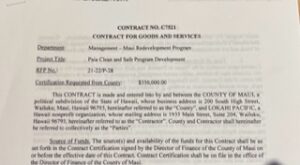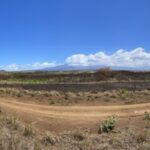
A $350,000 Maui County one-year contract intended to provide cleaning and “safety” services to Paia is largely unspent after 10 months, a time period marked by growing anger from merchants and residents over the deterioration of the town.
Just 18% of the contract, some $62,500, has been spent by program director Lawrence Kauha’aha’a since late November 2021, when the one-year contract was approved and issued by the Maui County Department of Management. Now, facing questions about the program’s execution, county and program officials are scrambling to officially “launch” Paia Clean and Safe at a community meeting in October, just weeks before the contract expires and the money disappears.
The contract was given to Kauha’aha’a because of similar, successful programs he currently oversees in Lahaina and Wailuku. The contract’s “Clean” terms included twice-daily trash pickup from waste receptacles, sidewalk sweeping, landscaping, and graffiti removal. The “Safe” portion involved using “Safety and Outreach Ambassadors” who would circulate through town answering questions and serving as “eyes and ears” for Maui Police Department [MPD] officers.
None of the cleaning services have been provided. “Outreach Social Workers” were not hired. So far, most of the money has been spent on employing two individuals who split a daily 10-hour shift “walking around town,” as one of them put it. Many merchants and residents seem unaware of their existence.
During the same time period, the situation in Paia has worsened. Recently, a group of Paia residents and merchants held meetings to discuss the town’s trash, crime and vagrancy problems. During the first two meetings, one resident reported shots fired at her store. Others said they no longer let their children walk through town unattended. Still others complained about the litter of discarded syringes and open drug use. During these meetings, which were also attended by county officials, the Paia Clean and Safe program was mentioned, but attendees seemed not to know that the program was already in operation and had been since the beginning of the year.
Paia community’s the problem
It’s easy to respond to this news with a full-throated “What the hell?” The harder part is examining the reasons why this well-intended, well-funded effort seems to have fallen flat on its face.
Program director Kauha’aha’a blamed COVID, the Maui Police Department, the county, and Paia sidewalk size, among other things, during a lengthy, frustration-filled interview about his problems establishing Paia Clean and Safe. Mainly though, Kauha’aha’a faults the Paia community itself. “The biggest obstacle is community involvement,” he said. “Lahaina took back their town; Wailuku took back their town. Most people over there [in Paia] are just hoping somebody else will [take care of the problems]. They just want [the problems] to go away and they don’t want to be the ones that have to do it.”
Further, Kauha’aha’a declared, without nearby housing and “wrap-around mental health services” (neither included in the scope of his contract), Paia’s unsheltered population’s problems will forever remain unchanged. “They’re just going to go from one place to another until we can provide something.”
He said more than once that he would be happy to walk away from the effort: “Maybe me and Paia don’t fit.”
Best intentions
The “Paia Clean and Safe” program was born out of the best of intentions. The tiny North Shore town of 2,500 is one of the most visited places on Maui. Known for its funky beach vibe, Paia was tilting heavily into “funk” as the pandemic progressed. The municipal parking lot and surrounding lawn had turned into a de facto homeless compound, with several of its more impaired residents wandering streets and sidewalks and causing trouble.
After hearing numerous complaints from community members, Maui County Council Member Mike Molina declared the situation a “district priority.” He successfully urged his council colleagues to allocate funds for program in Paia similar to the one in Wailuku. The Wailuku program, started in 2016, received great press for efforts that included local, unsheltered residents hired to sweep sidewalks and safety patrols strolling the business district. The council authorized a series of Paia Town-directed monies ($150,000 in Fiscal Year 2021, $250,000 in 2022, and $50,000 in 2023.).
“We gave the administration the tools,” Molina said in an interview, adding that he was “very disappointed so far with the lack of progress on this.” His office has written the administration asking for detailed line items on the funds already spent during those fiscal years.
The program
On the administration side, Erin Wade, Planning and Development Chief for the Department of Management, prepared a Request for Proposal [RFP] for a “Paia Clean and Safe Development Program. The RFP referenced existing programs in Wailuku and Lahaina, saying that the Paia community had requested a similar program.
The first priority was waste. The RFP stated the county was “in the process of purchasing eight trash receptacles” to serve the Paia business district—similar to the heavy concrete, rummage-proof containers in Wailuku and Lahaina. The program contractor was to “continually service and empty them while taking on other various cleaning activities throughout the day” on a 365-day basis. The cleaning service would also include “landscape maintenance, sidewalk sweeping and cleaning, graffiti removal in public spaces, and citizen assistance when requested.”
The second part of the RFP called for ‘Safety and Aloha Outreach Ambassadors,” who would “ensure a safe and welcoming environment for visitors, workers and residents.” In addition to interfacing with community members and visitors, the ambassadors would serve as “an additional set of eyes and ears for the MPD” and work to “reduce vagrancy,” provide outreach services and conduct daily patrols “with the goal of deterring illegal behavior and recommending crime reduction improvements.” They would also “develop relationships with district businesses.”
The bids
Two companies responded to the RFP. Both were run by former MPD officers. The proposal from Lifefit estimated a $368,700 annual budget. The proposal submitted by Kauha’aha’a (through the nonprofit, Wailuku-based Lokahi Pacific, which can collect up to $35,000 as the contract’s fiscal agent) estimated a $350,000 budget.
Kauha’aha’a was awarded the contract. In addition to his Wailuku and Lahaina programs, he enjoyed a long-time working relationship with Wade. In an interview, Wade explained that she met Kauha’aha’a years earlier when he was a community police officer in Lahaina.
When Wade’s responsibilities shifted to Wailuku in 2015, the town was facing “a tremendous vagrancy problem,” she recalled. Wade had studied “Clean and Safe” programs being operated on the mainland, but companies there wanted big bucks to consult on Maui. Wade contacted Kauha’aha’a, who by then had retired from the MPD. “Lawrence wasn’t that familiar with Wailuku, but the two of us spent three months walking around town. We got to know the situation, talked to merchants, and tried to understand the characters who were creating the issues.”
Kauha’aha’a helped Wade design an RFP for “Wailuku Clean and Safe,” and then “the next thing you know, he put in a bid,” she said. Kauha’aha’a has had that contract renewed for the past four years. He later accepted another contract to run a similar program in Lahaina.
It’s not clear how much Kauha’aha’a studied Paia prior to putting in his bid for the town’s “Clean and Safe” program, but Wade now acknowledges that there were flaws in the original RFP. “We thought, ‘We’ll just do the cookie cutter solution that we came up with for [Lahaina and Wailuku].”
She added that Kauha’aha’a may have taken on the contract “out of loyalty. Because he was worried that somebody else could get in trouble with it.”
Given the way the program was outlined, it seemed like almost anyone who took the contract was facing trouble. The contractual “cookie cutter” requirements to clean up and secure Paia had little to do with the actual town.
No “Clean”
The “Clean” part of the “Clean and Safe” program instantly fell by the wayside. The proposed trash receptacles used in Lahaina and Wailuku wouldn’t work. According to Kauha’aha’a, “The sidewalks weren’t wide enough. And you couldn’t put them in parking stalls—that wasn’t going to be hugely popular.”
So the county never ordered them. Plus, he said, “the county didn’t have a place to put a dumpster for us to put the trash into.”
The trash situation particularly irritated Molina. “That was the one thing some of the merchants were asking for, rubbish cans. I thought at least we’d have those by now.”
In the interim, Paia resident Brian McCafferty, who runs the Paia nonprofit “Teens On Call Maui,” stepped into the void. He pays community teenagers to periodically pick up trash around town and drives it himself to the county dump.
Kauha’aha’a said McCafferty’s program was good, but not “consistent” enough. Currently, the county has started to pay McCafferty for the service, Wade confirmed. The Paia Safe and Clean funds for trash collection remain unspent.
Kauha’aha’a said he couldn’t hire homeless residents to sweep the sidewalks because there was no social service agency in Paia that could handle employment matters, such as collecting social security numbers in order to issue checks. “It’s a county contract, you can’t pay in cash,” he explained.
No “Safe”
The “Safe” part of “Clean and Safe” was clobbered by decisions outside Kauha’aha’a’s control.
The Clean and Safe approach to community safety was multi-pronged, he explained. As he’d done in other communities, he said, he first would hold a large community meeting to explain the program’s details. The Clean and Safe program employees were not policeman, nor even licensed guards. They functioned instead as “security coaches.”
The coaches “will teach you step-by-step how to secure your property, how to remove people from your property, how to contact and utilize police,” he explained. “You can’t just make an anonymous call; you have to be the one who can testify. And we show them the best practices on doing paperwork.”
Kauha’aha’a’s safety program hinged on having a community police officer [CPO] who would work “hand in hand” with the “security coaches” and the public. Who could be there “within three minutes” if called. That essential element was broadsided in January, when newly installed MPD chief John Pelletier removed community police officers from all Maui towns in order to address the department’s ever-growing personnel shortage (currently estimated at 65% of normal).
“The chief has openly said that homelessness is not a police issue,” Kauha’aha’a said, countering, “And it may not be–but the associated crimes are.” The MPD’s elimination of its full-time CPOs “makes it impossible to do what we do,” he added.
Kauha’aha’a complained directly to Pelletier. “I was trying to get him to understand how much people loved the community police officer in Paia. I told him, ‘You need the continuity of working with the same officer every day. You won’t get the same results sending a different person.’”
Wade acknowledged that Paia has been particularly hard hit by the lack of a community police officer. “Both Wailuku and Lahaina have designated parking officers as well. So even though the CPOs have left, they do still have some kind of community police presence.”
MPD spokeswoman Alana Pico said the department is now sending a CPO to Paia one day a week, though the days and times vary.
No formal meeting
There never was a large community meeting held at the beginning of the contract because of Covid concerns, Kauha’aha’a said. Instead, he explained, he met with a few small groups of residents. One included representatives from the Paia Youth and Cultural Center (PYCC), and Paia activist and resident Francine “Aunty Mopsy” Aarona. He didn’t enjoy it very much. “We got yelled at.”
Paia Youth and Cultural Center Executive Director Susun White chuckled when she was told about Kauha’aha’a’s comments. “Lawrence’s whole thing was that it was impossible for him to do the work he needed to do without a community cop. I never yelled at anyone.”
White described the situation at PYCC’s location east of Baldwin Beach as “sketchy. We don’t let our kids walk to town alone anymore.” She said matters have improved during the year, but not because of the Paia Clean and Safe Program. “We’ve gotten great support from the Parks Department and the actual real cops.”
PYCC Deputy Director Benjamin Rachunas also attended the meeting with Kauha’aha’a and recalled, “He pretty much talked the entire time. We really didn’t get to say much. We parted on pleasant terms and were excited for what was to come. Then absolutely nothing happened after that.”
In contrast, Rachunas recalled a meeting with Paia landowner Sam Hirbod following a July 30 fire that revealed illegal encampments and dozens of abandoned cares on Hirbod’s 339-acre parcel across the street from the PYCC. Rachunas said Hirbod followed through on his promises to clean his property and hire security officers, retaining former MPD officer Melvin Johnson’s Aegaeon Security. “They arrived immediately and patrolled around. So it’s been less of a scene for us because that was directly in our zone.”
“Actually it’s a better scene here at the PYCC right now than in town,” he added. “I never felt safe parking in our [Lower Paia Park] lot, but now I actually don’t feel safe parking in town.”
Aarona said she told Kauha’aha’a at the meeting, “We really don’t know what you’re responsible for. We need to hear what is being done so that we have a better idea of where this money is going.”
Aarona’s opinion: “Lawrence is not a good fit. If he’s not in compliance with the contract, then the county needs to do something.”
A different town
Whether or not Paia’s community has a bad attitude—as Kauha’aha’a claims—the town is not the same as Lahaina or Wailuku. Wailuku is the home to more social service agencies than anywhere else in Maui County. Lahaina has lots of public spaces and the Lahaina Restoration Foundation, which oversees a trash pick-up program. And both towns still have designated police officers, even if they’re only for parking enforcement.
Paia Town is 90% private property. There are no permanent social service agencies in the area offering shelter, mental health assistance, or food. The town’s public space is basically a couple parking lots. Wade was candid about the Paia Clean and Safe program’s failure to properly address those differences, as well as not letting the Paia community know earlier about the Clean and Safe program.
“I didn’t want to have a meeting and promise something that actually wasn’t going to get delivered,” she said. “Now I realize that that moment was earlier, and I missed it. We probably should have done this [large meeting]at the beginning of the summer.”
“Information” in October
Wade says she wants to get a more pertinent program underway at a community meeting tentatively planned for early October [I will issue an update when a date and time are set].
The meeting agenda will include, “Information about how the ambassador part of the program works, and what everyone’s role is for it to work well. We will talk about the parts of the program that haven’t been started–and why–and what some alternatives could be.” Wade said Kauha’aha’a will remain the program’s director.
Kauha’aha’a says he won’t tolerate a lot of “screaming and yelling” during that meeting. “I’ll leave. If people don’t see the value of it and they want to go back to the way Paia was, then they can do that. It’s fine with me. Somebody else can go try to do what they want to do.”
Wade was more diplomatic. “We’ve got to start fresh. The model needs to shift. This program is going to need to be reinvented in a way that fits Paia. The people who want to come to the table to do the work are the people we want doing the work.
“We need a public-private partnership. It would be great to have someone private, like Melvin [Aegaeon Security] who could represent the businesses, working with a publicly funded service whose focus is the streets and the parking lot.”
She emphasized, “Paia’s private businesses have to have somebody at their own direction. I can’t use public dollars for that.”
Whether Wade will have additional county funding for the public portion or any “Clean and Safe” program remains an unknown. “We have not extended the time of performance on the contract or added any of the Fiscal Year 2023 funds at this time.”



I would like to say and re-affirm what Susun of PYCC said. There was no yelling. Covid has been used as an excuse but who am I to say. Everyone was on a trial and error basis. Pa’ia is a beautiful town that has allowed gentrification to settle in. The residents have that feeling of not belonging. We have to change that and it comes with respect for each other. There is a CORE group from the MPD who is trying to bring agencies to help those who don’t have food, clothing or a place to sleep. Medical and animal care has been a part of the outreach services. Once we identify the categories of our people who need assistance, we can begin to help each other. We are not going to satisfy everyone. We are not the mainland. We are homegrown island people who care for our aina. Ke Akuas Blessings and Mahalo
Thank you for your time with this letter, I have to say Paia has been looking much better last couple of weeks, people of Paia all must stay involved and keep our town clean and safe
I hope all show at next meeting in a show of being involved
Thanks Deborah! Your articles are always enlightening and informative. If it wasn’t for you, many people would have no idea what’s really going on. Hopefully everyone will come to this next meeting and we will all become organized in our efforts to make Paia clean & safe (great) again!
Excellent article, thank you Deborah!
I live in Haiku, I used to shop Paia. There is no parking. I gave up 10 years ago.